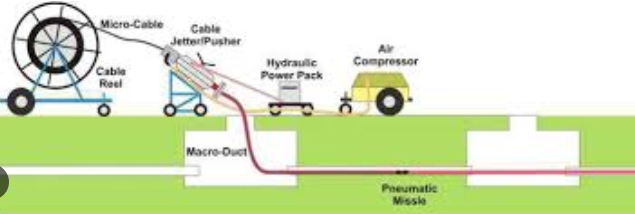Co Cable de Fibra óptico Oufu, Ltd
Enderezo: Shenyang, Liaoning, China.
Persoa de contacto: Xestor Zhang
Teléfono: 400-964-1314
Teléfono móbil: 86 13904053308
?
2025-09-23 16

So, what exactly is a fiber coiling pit? In essence, it's a designated underground chamber, often made of concrete or composite materials, specifically designed to safely store and manage excess lengths of Cable óptica de fibra. It's the network's insurance policy, allowing for future splices, repairs, and network changes without the need for new cable installation.
Understanding the function of this cable storage pit is the first step toward building a future-proof network.
Secret #1: It's Your Network's Strategic ReserveWww.adsscable.cn
The primary purpose of a fiber coiling pit is not just storage; it's about providing operational flexibility. When a cable break occurs, technicians can pull the coiled cable from the pit to create slack for splicing. This turns a multi-day repair job into one that can be completed in hours. According to industry data, having accessible cable slack can reduce mean time to repair (MTTR) by up to 70%.
Think of it as a spare tire for your network – it's there when you need it most.
Secret #2: The Anatomy of a High-Performance Pit
Not all pits are created equal. A well-designed fiber optic handhole or manhole includes several key features:
Robust Enclosure: Must be waterproof and strong enough to withstand soil pressure and surface loads.
Proper Coiling Space: Ample space to coil the cable while respecting its minimum bend radius.
Secure Mounting Points: For fixing the cable and the splice closure.
Clear Identification: Labels indicating the cable type and route.
This thoughtful design prevents micro-bends, crush damage, and moisture ingress, which are common causes of signal loss.
Secret #3: Manhole vs. Handhole - Choosing the Right Type
The choice between a manhole and a handhole depends on the scale and purpose of the installation. This is a key decision in fiber coiling pit planning.
| Feature | Manhole (Large Pit) | Handhole (Small Pit) |
|---|---|---|
| Size & Access | Large enough for a person to enter | Only large enough for hand access |
| Typical Use Case | Mainline cables, multiple splices, major network nodes | Distribution points, drop cable locations, minor branches |
| Cost & Complexity | Higher | Lower |
| Cable Capacity | High | Low to Moderate |
For most access network applications, a handhole is sufficient. However, for critical backbone junctions, a full-sized manhole is necessary.
Secret #4: A 5-Step Guide to Flawless Pit Installation
Installing a fiber coiling pit correctly is crucial. Here's a step-by-step process:
Site Selection: Choose a stable, accessible location away from potential water accumulation or future excavation sites.
Excavation and Bedding: Dig the hole to the required depth and create a stable, level bed of sand or gravel.
Place the Pit: Carefully lower the pre-cast pit or assemble it in place, ensuring it is level.
Conduit Entry and Sealing: Feed the conduits into the pit and use specialized seals to create a watertight and rodent-proof barrier.
Backfilling: Backfill around the pit in layers, compacting each layer to avoid void formation and future settlement.
⚠️ Note: The most common mistake is improper sealing of conduit entries. Even a small gap can allow water to flood the pit, leading to cable degradation and potential failure. Always use high-quality sealing grommets.
Secret #5: The Hidden Value in Operational Efficiency
While the initial cost of a pit is an investment, its value is realized over the entire network lifecycle. We witnessed this on a project where a fiber coiling pit allowed us to quickly reroute a cable after an unexpected road widening project. Without that pit, the project would have been delayed by weeks and cost thousands Máis..
The ability to perform rapid repairs and adaptations from a fiber coiling pit translates directly into higher network availability and lower operational expenses.
Your Fiber Coiling Pit Implementation ChecklistWww.adsscable.cn
Purpose Defined: Is it for future splicing, repair slack, or a splice location?
Type Selected: Have you chosen between a manhole and a handhole based on needs?
Size Verified: Does the pit provide enough space for the required cable coil without violating bend radius?
Waterproofing Confirmed: Are all entry points properly sealed?
Documentation Updated: Is the pit's location and purpose clearly marked on network maps?
Mastering the use of the fiber coiling pit is a mark of a professional network design. It’s a simple concept that delivers profound reliability benefits.
Frequently Asked Questions (FAQs)
Q: How much extra cable should be coiled in a pit?
A: A common standard is to coil enough for at least two full splices, typically 15-30 meters for trunk lines and 8-15 meters for distribution lines.
Q: Can multiple cables be stored in one pit?
A: Yes, but they must be neatly coiled and separated to avoid tangling. Adequate space is critical to prevent violating bend radius rules.
Q: How deep should a fiber coiling pit be buried?
A: The depth depends on local regulations and the surface load (e.g., sidewalk vs. roadway). Typically, the top of the pit should be flush with the final grade level.Www.adsscable.cn
Q: What is the difference between a coiling pit and a splice closure?
A: The pit is the underground enclosure that provides physical protection and space. The splice closure is the plastic or metal case inside the pit that actually protects the fused fibers.
Q: How often should coiling pits be inspected?
A: They should be inspected annually for signs of water infiltration, debris, or damage, and especially after any nearby construction activity.